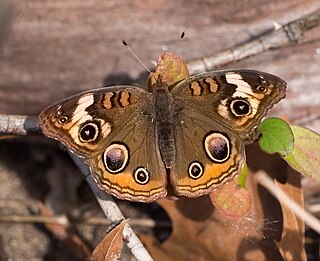
Junonia coenia, known as the common buckeye or buckeye, is a butterfly in the family Nymphalidae. Its range covers much of North America and some of Central America, including most of the eastern half of the US, the lower to middle Midwest, the Southwest, southern Canada, and Mexico. Its habitat is open areas with low vegetation and some bare ground. Its original ancestry has been traced to Africa, which then experiences divergence in Asia. The species Junonia grisea, the gray buckeye, is found west of the Rocky Mountains and was formerly a subspecies of Junonia coenia.

The meadow argus is a butterfly in the family Nymphalidae, commonly found in Australia and Nelsons Island. It is also known as Albin's Hampstead eye in the United Kingdom, where it has occurred only as an accidental import.

Junonia evarete, the tropical buckeye or South American tropical buckeye, is a South American butterfly of the nymphalid (Nymphalidae) family. It has characteristic eye spots on the wings, which have a wingspan between 4.5 and 6.5 cm. This butterfly is easily confused with Junonia genoveva, the mangrove buckeye. Not only have the common names mangrove and tropical buckeye been confused, but the butterflies themselves have been sometimes misidentified in past literature because the two species have many variations, subspecies and seasonal forms, which makes them difficult to identify or differentiate. Phylogenetic studies demonstrate the separation of evarete and genoveva, but evidence suggests that subspecies and perhaps more species await their descriptions within this group.

Junonia genoveva, the mangrove buckeye, is a butterfly of the family Nymphalidae. The species was first described by Pieter Cramer in 1780. It is found in South America, and possibly into Central America.

Junonia natalica, the Natal pansy or brown pansy, is a butterfly of the family Nymphalidae. It is found in the Afrotropical realm.
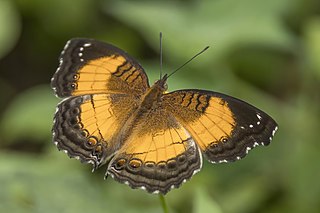
Junonia terea, the soldier pansy or soldier commodore, is a butterfly of the family Nymphalidae. The species was first described by Dru Drury in 1773. It is found in the Afrotropical realm.

Protogoniomorpha parhassus, the forest mother-of-pearl or common mother-of-pearl, is a species of Nymphalidae butterfly found in forested areas of Africa.

Junonia orithya is a nymphalid butterfly with many subspecies occurring from Africa, through southern and south-eastern Asia, and in Australia. In India, its common English name is the blue pansy, but in southern Africa it is known as the eyed pansy as the name blue pansy refers to Junonia oenone. In Australia, this butterfly is known as the blue argus, but this name also is used for the Aricia anteros in Europe.
Junonia africana is a butterfly in the family Nymphalidae. It is found in Cameroon.

Junonia artaxia, the African pansy or commodore, is a butterfly in the family Nymphalidae. It is found in eastern Angola, the Democratic Republic of the Congo Burundi, Kenya, southern and western Tanzania, Zambia, Malawi, Mozambique and Zimbabwe. The habitat consists of Brachystegia woodland.
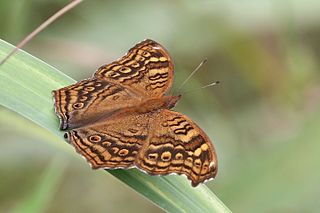
Junonia chorimene, the golden pansy, is a butterfly in the family Nymphalidae. It is found in Senegal, the Gambia, Guinea-Bissau, Guinea, Mali, Sierra Leone, Ivory Coast, Burkina Faso, Ghana, Togo, Benin, Nigeria, the Democratic Republic of the Congo, Sudan, Ethiopia, Uganda, northern and western Kenya, northern Tanzania, south-western Arabia and Yemen. The habitat consists of riverine vegetation.
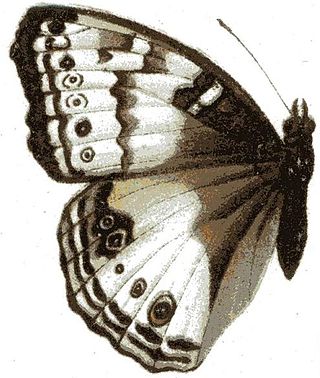
Junonia hadrope, the Volta pansy, is a butterfly in the family Nymphalidae. It is found in Ghana.

Junonia rhadama, the brilliant blue, is a butterfly in the family Nymphalidae. It is found on Madagascar, Mauritius, Rodrigues, Réunion, the Comoros, and the Seychelles. The habitat consists of transformed grasslands and Anthropogenic biomeanthropogenic environments.

Junonia stygia, the brown pansy, dark pansy or Aurivillius' brown pansy, is a butterfly in the family Nymphalidae. It is found in Senegal, Guinea-Bissau, Guinea, Sierra Leone, Liberia, Ivory Coast, Ghana, Togo, Nigeria, Cameroon, Gabon, the Republic of the Congo, the Central African Republic, Angola and the Democratic Republic of the Congo. The habitat consists of forests, including disturbed areas and secondary forests.

Junonia gregorii, or Gregori's brown pansy, is a butterfly in the family Nymphalidae. It is found in eastern Nigeria, Cameroon, Gabon, the Republic of the Congo, the Democratic Republic of the Congo, Uganda, western Tanzania and Kenya. The habitat consists of edges of sub-montane forests and agricultural clearings.
Junonia ansorgei, or Ansorge's leaf butterfly, is a butterfly in the family Nymphalidae. It is found in Cameroon, the eastern part of the Democratic Republic of the Congo, southern Ethiopia, Uganda, western Kenya, western Tanzania and Zambia. It is generally found in dense forests.

Junonia cymodoce, the blue leaf butterfly or blue leaf pansy, is a butterfly in the family Nymphalidae. It is found in Guinea, Ivory Coast, Ghana, Togo, Benin, Nigeria, Cameroon, Equatorial Guinea, São Tomé and Príncipe, the Republic of the Congo, Angola, the Central African Republic, the Democratic Republic of the Congo, western Uganda, western Tanzania and north-western Zambia. The habitat consists of lowland forests.
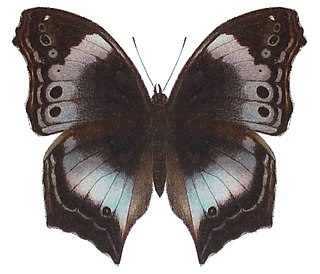
Protogoniomorpha cytora, the western blue beauty, is a butterfly in the family Nymphalidae. It is found in Guinea, Sierra Leone, Liberia, Ivory Coast, Ghana, Togo, and Benin. The habitat consists of open spaces in primary forests and mature secondary forests.

Euploea goudotii is a butterfly in the family Nymphalidae. It is found on La Reunion.

















